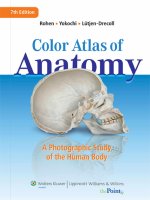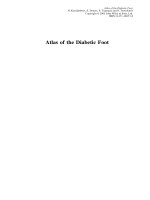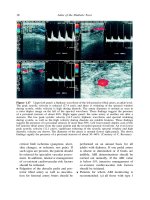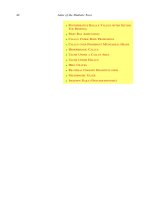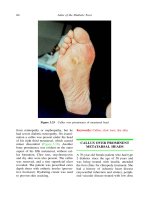Ebook Atlas of the human body: Part 1
Bạn đang xem bản rút gọn của tài liệu. Xem và tải ngay bản đầy đủ của tài liệu tại đây (10.18 MB, 121 trang )
LWBK244-4102G-FM_i-xii.qxd 12/16/08 5:35 AM Page i Aptara.Inc.
Coloring Atlas
of the Human Body
LWBK244-4102G-FM_i-xii.qxd 12/16/08 5:35 AM Page ii Aptara.Inc.
LWBK244-4102G-FM_i-xii.qxd 12/16/08 5:35 AM Page iii Aptara.Inc.
Coloring Atlas
of the Human Body
Kerry L. Hull, BSc, PhD
Professor
Department of Biology
Bishop’s University
Sherbrooke, Quebec
Canada
LWBK244-4102G-FM_i-xii.qxd 12/16/08 5:35 AM Page iv Aptara.Inc.
Acquisitions Editor: David Troy
Managing Editor: Renee Thomas
Marketing Manager: Allison Noplock
Project Manager: Rosanne Hallowell
Design Coordinator: Teresa Mallon
Production Services: Aptara, Inc.
Copyright © 2010 Lippincott Williams & Wilkins, a Wolters Kluwer business.
351 West Camden Street
Baltimore, MD 21201
530 Walnut Street
Philadelphia, PA 19106
Printed in China
All rights reserved. This book is protected by copyright. No part of this book may be reproduced or transmitted in any form or by any means, including as photocopies or scanned-in or other electronic copies, or
utilized by any information storage and retrieval system without written permission from the copyright
owner, except for brief quotations embodied in critical articles and reviews. Materials appearing in this book
prepared by individuals as part of their official duties as U.S. government employees are not covered by the
above-mentioned copyright. To request permission, please contact Lippincott Williams & Wilkins at 530 Walnut Street, Philadelphia, PA 19106, via email at , or via website at lww.com (products
and services).
9
8
7
6
5
4
3
2
1
Library of Congress Cataloging-in-Publication Data
Hull, Kerry L.
Coloring atlas of the human body / Kerry L. Hull.
p. ; cm.
Includes bibliographical references and index.
ISBN 978-0-7817-6530-5 (alk. paper)
1. Human anatomy—Atlases. 2. Human physiology—-Atlases. 3. Coloring
books. I. Title.
[DNLM: 1. Anatomy—Atlases. 2. Anatomy—Problems and Exercises.
3. Physiology—Atlases. 4. Physiology—Problems and Exercises. QS 17
H913c 2010]
QM25.H835 2010
611—dc22
2008050771
DISCLAIMER
Care has been taken to confirm the accuracy of the information present and to describe generally accepted practices. However, the authors, editors, and publisher are not responsible for errors or omissions or
for any consequences from application of the information in this book and make no warranty, expressed or
implied, with respect to the currency, completeness, or accuracy of the contents of the publication. Application of this information in a particular situation remains the professional responsibility of the practitioner; the
clinical treatments described and recommended may not be considered absolute and universal recommendations.
The authors, editors, and publisher have exerted every effort to ensure that drug selection and dosage
set forth in this text are in accordance with the current recommendations and practice at the time of publication. However, in view of ongoing research, changes in government regulations, and the constant flow of
information relating to drug therapy and drug reactions, the reader is urged to check the package insert for
each drug for any change in indications and dosage and for added warnings and precautions. This is particularly important when the recommended agent is a new or infrequently employed drug.
Some drugs and medical devices presented in this publication have Food and Drug Administration
(FDA) clearance for limited use in restricted research settings. It is the responsibility of the health care
provider to ascertain the FDA status of each drug or device planned for use in their clinical practice.
To purchase additional copies of this book, call our customer service department at (800) 638-3030 or
fax orders to (301) 223-2320. International customers should call (301) 223-2300.
Visit Lippincott Williams & Wilkins on the Internet: . Lippincott Williams & Wilkins
customer service representatives are available from 8:30 am to 6:00 pm, EST.
LWBK244-4102G-FM_i-xii.qxd 12/16/08 5:35 AM Page v Aptara.Inc.
I dedicate this book to my children, Lauren and Evan.
LWBK244-4102G-FM_i-xii.qxd 12/16/08 5:35 AM Page vi Aptara.Inc.
LWBK244-4102G-FM_i-xii.qxd 12/16/08 5:35 AM Page vii Aptara.Inc.
Preface
Coloring Atlas of the Human Body provides a comprehensive overview of human
anatomy and physiology for visually oriented and kinesthetic learners. This atlas is not a
traditional textbook; it requires active input from the reader. By coloring a series of specially designed diagrams and the accompanying flashcards, students will learn and remember concepts much more effectively than with traditional textbooks alone. The
completed coloring exercises and flashcards can also serve as tools to review and prepare for examinations.
This book is particularly suited to students taking their first 3-credit course in
anatomy and physiology. Coloring Atlas of the Human Body is a valuable supplement to
any anatomy and physiology text, but can also serve as a stand-alone text.
Why Color?
Coloring is an excellent way to learn about the structure (anatomy) and function (physiology) of the human body. Anatomy, by its nature, is learned primarily by memorization.
Coloring helps students remember because they must pay attention to detail, visualize
structures, and physically feel the relationship between different structures as they
color. Physiology builds upon anatomical knowledge by explaining how structures accomplish particular tasks. Learning physiology requires some memorization, which is facilitated by the coloring process, but it also requires an additional level of conceptual understanding. Complex pathways and principles must be broken down into component
parts and subsequently reassembled and related to other pathways. Students using the
Coloring Atlas of the Human Body approach will deepen their understanding of physiology because they can visualize the participation of structures and components in the
pathway. Moreover, the necessity of coloring one section of a diagram at a time helps
students to break the pathways into their component parts. Once a pathway is understood as a function of its parts and as a whole, its relevance to disease can also be understood.
Best of all, coloring is fun for students—a welcome distraction from more static
studying activities such as reading and memorizing!
Organization
Coloring Atlas of the Human Body follows the systems approach favored by traditional
anatomy and physiology textbooks, so it can be used with any such book. The first chapter summarizes fundamental concepts in anatomy, cell biology, and histology. Students
will find it useful to complete these exercises before proceeding with the rest of the
book. Subsequent chapters deal with the anatomy and physiology of different body
systems, and need not be completed in order.
Some chapters also discuss selected aspects of disease. Sometimes, the normal
functioning of a system can be best understood by studying the problems caused by
disease. The effects of insulin, for example, are brought to life by learning about diabetes mellitus.
Each exercise contains two parts: a narrative page and a figure page. The narrative
page summarizes critical information using bulleted lists, tables, and flowcharts, and directs the reader to the matching flashcards (if any) in Appendix I. As students read
through the narrative, they will be asked to color in relevant structure names and the
structures themselves on the diagram on the facing page. The action of coloring the
structure name and the structure will help students remember the spelling and location
of the structure. In addition, the completed diagram will serve as a useful reference and
review tool, since it will be easy to match different structures to the different terms.
LWBK244-4102G-FM_i-xii.qxd 12/16/08 5:35 AM Page viii Aptara.Inc.
Flashcards
Some coloring exercises cover content students often have trouble remembering.
These exercises have accompanying flashcards that can be found at the back of the
book in Appendix I. The front of each flashcard features a magnified view of a section of
the coloring exercise figure with up to 15 labeled structures, with the names of the
structures featured on the back. Students can rip out flashcards that accompany a
particular exercise and color them in conjunction with the larger figure, using the same
color scheme. In addition to the extra reinforcement that coloring the flashcards provides, students benefit from being able to use the colored-in flashcards anywhere—on
the bus or walking to class—as a portable study tool for review and self-testing.
Additional Student Resources
For students who have purchased the book, Coloring Atlas of the Human Body also
includes two bonus Coloring Exercises as well as helpful study tips, available on the
companion website at www.thepoint.com/HullColoringAtlas. See the inside front cover
of this text for more details, including the passcode you will need to gain access to the
website.
In short, the Coloring Atlas of the Human Body provides an essential learning package for today’s visually oriented students. It integrates two popular and effective learning tools—coloring guides and flashcards—to help students learn challenging concepts
and evaluate their progress.
viii
LWBK244-4102G-FM_i-xii.qxd 12/16/08 5:35 AM Page ix Aptara.Inc.
Acknowledgments
I would like to thank Barbara Cohen, author of Memmler’s Human Body in Health and
Disease and Memmler’s Structure and Function of the Human Body, for her tremendous
leadership and support as I began my forays into textbook writing.
A number of individuals at LWW were instrumental in this project, including David
Troy, John Goucher, Dana Knighten, and Renee Thomas. Enormous thanks are due to
Jennifer Clements and to the artists at Dragonfly Media Group, who were able to turn
my rough sketches into instructive and attractive drawings. I would also like to acknowledge the reviewers, whose feedback and suggestions were invaluable.
Finally, I thank my husband, Norman Jones, for his unstinting support and willingness to take on many household tasks, and my parents, Bill and Lorraine Hull, who
always incouraged my interest in all things biomedical.
LWBK244-4102G-FM_i-xii.qxd 12/16/08 5:35 AM Page x Aptara.Inc.
x
LWBK244-4102G-FM_i-xii.qxd 12/16/08 5:35 AM Page xi Aptara.Inc.
Contents
Chapter 1 ➤ Fundamentals of Anatomy
and Physiology 2
Coloring Exercises
1-1.
1-2.
1-3.
1-4.
1-5.
Organ Systems and Levels of Organization 2
Directional Terms and Planes of Division 4
Body Cavities and Abdominal Regions 6
Cell Structure 8
The Plasma Membrane and
Chromosomes 10
1-6. Membrane Transport 12
1-7. Tissues 1: Epithelial Tissues 14
1-8. Tissues 2: Connective Tissues 16
Chapter 2 ➤ The Skin
18
22
Coloring Exercises
3-1.
3-2.
3-3.
3-4.
3-5.
3-6.
3-7.
3-8.
3-9.
3-10.
3-11.
3-12.
3-13.
5-1.
5-2.
5-3.
5-4.
5-5.
5-6.
5-7.
5-8.
5-9.
5-10.
5-11.
Organization of the Nervous System 70
Nervous Tissue 72
The Action Potential 74
Transmission of Nerve Impulses 76
The Spinal Cord and Spinal Reflexes 78
The Spinal Nerves 80
The Brain 82
The Cerebral Cortex and the Meninges 84
The Ventricles and Cerebrospinal Fluid 86
The Cranial Nerves 88
The Autonomic Nervous System 90
The Skeletal System: An Overview 22
Long Bone Structure and Fractures 24
Compact Bone Tissue 26
Joints: Classification 28
Synovial Joints: Structure and Disease 30
The Skull 32
The Vertebral Column 34
The Thorax and Shoulder Girdle 36
The Upper Limb 38
The Pelvis and Hip Joint 40
The Lower Limb 42
The Hand and Foot 44
Movements at Synovial Joints 46
Chapter 4 ➤ The Muscular System
92
Coloring Exercises
18
Chapter 3 ➤ The Skeletal System
70
Coloring Exercises
Chapter 6 ➤ The Sensory System
Coloring Exercises
2-1. Skin Structure and Function
2-2. Skin Disorders 20
Chapter 5 ➤ The Nervous System
48
Coloring Exercises
4-1. Muscle Tissue and Skeletal Muscle
Anatomy 48
4-2. The Neuromuscular Junction 50
4-3. Muscle Contraction 52
4-4. Energy for Working Muscles: ATP 54
4-5. Muscles in Action 56
4-6. Muscles of the Head 58
4-7. Muscles of the Torso 60
4-8. Muscles that Move the Upper Limb 62
4-9. Muscles that Move the Lower Limb 64
4-10. Skeletal Muscles Review (Part 1) 66
4-11. Skeletal Muscles Review (Part 2) 68
6-1.
6-2.
6-3.
6-4.
6-5.
6-6.
6-7.
6-8.
Touch and Pain 92
The Eye 94
Muscles of the Eye 96
Vision and Vision Abnormalities 98
Anatomy of the Ear 100
Physiology of the Ear: Hearing 102
Physiology of the Ear: Equilibrium 104
The Chemical Senses: Smell and Taste 106
Chapter 7 ➤ The Endocrine System:
Glands and Hormones 108
Coloring Exercises
7-1. The Endocrine System and the
Endocrine Glands 108
7-2. The Parathyroid Glands and Calcium
Metabolism 110
7-3. The Pancreas and Glucose
Metabolism 112
7-4. The Pituitary Gland: Posterior Lobe 114
7-5. The Pituitary Gland: Anterior Lobe 116
7-6. Thyroid Hormones 118
7-7. Adrenal Hormones: Epinephrine and
Aldosterone 120
7-8. Adrenal Hormones: Glucocorticoids 122
Chapter 8 ➤ The Cardiovascular
System 124
Coloring Exercises
8-1. The Cardiovascular System: An
Overview 124
8-2. The Pulmonary and Systemic
Circulations 126
LWBK244-4102G-FM_i-xii.qxd 12/16/08 5:35 AM Page xii Aptara.Inc.
8-3.
8-4.
8-5.
8-6.
8-7.
8-8.
8-9.
8-10.
8-11.
8-12.
8-13.
8-14.
8-15.
8-16.
Blood 128
Blood: Formed Elements 130
Hemostasis: Blood Loss Prevention 132
Anatomy of the Heart 134
The Cardiac Vessels 136
The Cardiac Cycle and Conducting
System 138
Branches of the Aorta 140
Systemic Arteries 142
Arterial Supply to the Head 144
Systemic Veins: Upper Body 146
Systemic Veins: Lower Body 148
Venous Drainage of the Head 150
Blood Pressure 152
Blood Flow: Capillary Beds and Veins 154
Chapter 11 ➤ The Digestive
System 182
Coloring Exercises
11-1.
11-2.
11-3.
11-4.
11-5.
11-6.
Anatomy of the Digestive System
The Digestive Tract Wall 184
The Oral Cavity and Teeth 186
The Stomach 188
Accessory Organs 190
Small Intestine: Digestion and
Absorption 192
11-7. Regulation of Digestion 194
182
Chapter 12 ➤ The Urinary System and
Water Balance 196
Coloring Exercises
Chapter 9 ➤ The Lymphatic System and
Immunity 156
Coloring Exercises
9-1. The Lymphatic and Cardiovascular
Systems 156
9-2. Lymphatic Vessels 158
9-3. Lymphoid Tissues 160
9-4. Nonspecific and Immune Defenses 162
9-5. Immunity: Antigens and the Cellular
Response 164
9-6. Immunity: Humoral Response 166
9-7. Hypersensitivity Diseases 168
12-1.
12-2.
12-3.
12-4.
12-5.
Water Balance 196
The Urinary System 198
The Nephron and Its Blood Supply 200
Urine Formation 202
Regulation of Renal Function: ADH
and Urine Concentration 204
12-6. The Juxtaglomerular Apparatus and
Blood Pressure 206
12-6. Urinalysis 208
Chapter 13 ➤ Reproduction and
Heredity 210
Coloring Exercises
Chapter 10 ➤ The Respiratory
System 170
Coloring Exercises
10-1.
10-2.
10-3.
10-4.
10-5.
10-6.
The Respiratory System 170
Phases of Respiration 172
Ventilation 174
Gas Transport 176
Control of Breathing 178
Analysis of Lung Function and
Dysfunction 180
13-1.
13-2.
13-3.
13-4.
13-5.
13-6.
13-7.
13-8.
The Male Reproductive System 210
The Testis and Spermatogenesis 212
The Female Reproductive System 214
Fertilization: Spermatozoa and the Female
Internal Reproductive Organs 216
The Menstrual Cycle 218
The Placenta and Fetal Circulation 220
Mammary Glands and Lactation 222
Meiosis and Heredity 224
Appendix I ➤ Answers to Coloring Exercises
3-1, 4-10, and 4-11 227
Appendix II ➤ Pull-Out and Color Flashcards
228
xii
LWBK244-4102G-C01_01-17.qxd 12/16/08 4:56 AM Page 1 Aptara.Inc.
Coloring Atlas
of the Human Body
LWBK244-4102G-C01_01-17.qxd 12/16/08 4:56 AM Page 2 Aptara.Inc.
CHAPTER 1
Fundamentals of Anatomy and Physiology
Coloring Exercise 1-1 ➤ Organ Systems and Levels
of Organization
Levels of Organization
• Chemicals A
• Basic elements (e.g., sodium, calcium) or
• Combinations of elements
– Carbohydrates (e.g., sugars) – Fats (e.g., cholesterol)
– Proteins
– Nucleic acids (DNA, RNA)
• Cells B —see Coloring Exercise 1-4
• Contain organelles
• Constructed from chemicals
• Tissues C —see Coloring Exercises 1-7 and 1-8
• Specialized groups of cells
• Epithelial, connective, nervous, and muscle tissues
• Organs D —tissues functioning together
• Systems E
• Group of organs working together for the same general purpose
• Some organs are found in several systems
• Organism F systems cooperate to maintain and propagate organism
Body Systems
System
Structures
Major Functions
Integumentary
Skin and associated structures
Protection (chemical, mechanical)
Skeletal
Bones, ligaments, joints
Movement
Muscular G
Skeletal and smooth muscles
Movement
Nervous H
Neurons and ganglia; brain,
spinal cord, and nerves
Communication
Endocrine I
Glands
Communication
Cardiovascular J
Heart, blood vessels
Transportation (gases, nutrients,
wastes, heat)
Lymphatic K
Lymphatic vessels, lymph
nodes, tonsils, thymus, spleen
Protection (immune defense)
Respiratory L
Lungs and respiratory tract
Gas exchange (take in oxygen,
expel carbon dioxide)
Digestive
Mouth, esophagus, stomach,
intestine, liver, pancreas
Extraction of usable nutrients
from ingested food
Urinary M
Kidneys, ureter, bladder, urethra
Expulsion of waste and
excess water
Reproductive
External sex organs, gonads,
internal duct systems
Production of offspring
2
COLORING INSTRUCTIONS
✍
Color each figure part and
its name at the same time,
using the same color. Color
the six different levels of
organization (parts A to F ).
COLORING INSTRUCTIONS
✍
Color some examples of organs belonging to specific
systems (parts G to M ).
Color the corresponding
terms at the same time,
using the same color. Note
that you already colored the
digestive system, and that
the respiratory and urinary
systems are shown on the
same torso.
LWBK244-4102G-C01_01-17.qxd 12/16/08 4:56 AM Page 3 Aptara.Inc.
Chapter 1 Fundamentals of Anatomy and Physiology
A
G
B
H
C
D
I
E
J
F
K
L
M
3
LWBK244-4102G-C01_01-17.qxd 12/16/08 4:56 AM Page 4 Aptara.Inc.
Coloring Exercise 1-2 ➤ Directional Terms and Planes
of Division
Directional Terms
• Terms apply to body in anatomic position (upright, face front, arms at sides,
palms forward, feet parallel)
• Terms describe position of one structure in relation to another
Term
A
Superior: above
Opposite Term
B
Inferior: below
Example
B Caudal: closer to “tail”
(sacrum)
Nose is cranial to mouth;
mouth is caudal to nose
C Ventral/Anterior:
closer to front (belly)
D Dorsal/Posterior: closer
to back
Sternum is ventral to vertebrae;
vertebrae are dorsal to sternum
G Medial: closer
to midline
F
Distal: farther from origin
H Lateral: farther from
midline
Knee is proximal to ankle;
ankle is distal to knee
Nose is medial to ears;
ears are lateral to nose
Planes of Division
• Frontal plane I
• Longitudinal plane, in line with ears
• Divides body into unequal anterior and posterior sections
• Sections along this plane called longitudinal or coronal (not shown)
• Sagittal plane J
• Longitudinal plane, perpendicular to ears
• Divides body into right and left portions
• Sections along this plane called longitudinal or sagittal K
• Midsagittal section: cut body down midline
• Transverse plane L
• Divides body into unequal upper and lower segments
• Also called horizontal plane
• Sections along this plane called transverse or cross sections M
• Angled sections called oblique sections N
4
each arrow (representing
A to H ) and its corresponding term at the same
time, using the same color.
Lungs are superior to intestines;
intestines are inferior to lungs
A Cranial: closer to
head
E Proximal: closer
to origin
COLORING INSTRUCTIONS
✍
On the top figure: color
COLORING INSTRUCTIONS
✍
On the bottom figure: color
the three planes ( I , J , L )
and the types of sections
( K , M , N ) the same color
as the corresponding terms
in the list.
LWBK244-4102G-C01_01-17.qxd 12/16/08 4:56 AM Page 5 Aptara.Inc.
Chapter 1 Fundamentals of Anatomy and Physiology
A
E
G
C
D
H
F
B
I
K
L
J
M
N
5
LWBK244-4102G-C01_01-17.qxd 12/16/08 4:56 AM Page 6 Aptara.Inc.
Coloring Exercise 1-3 ➤ Body Cavities and Abdominal
Regions
Body Cavities
• Body organs contained within CAVITIES (large spaces)
• Cavities lined with bone (dorsal cavities) or membranes (ventral cavities)
A
B
cranial:
brain
D
dorsal
C
spinal:
spinal cord
E
thoracic:
lungs, heart,
large vessels,
mediastinum
H
ventral
diaphragm
separates
F
abdominal:
stomach, intestine, spleen,
liver, gallbladder, pancreas
pelvic:
bladder, rectum, internal
reproductive organs
Abdominal Regions
Remember that right and left refer to the PATIENT’S right and left, not yours!
• Abdomen divided into nine regions by four lines
• Two horizontal lines, just inferior to ribcage and just inferior to the top of
hipbones
• Two vertical lines just medial to both nipples
• Three central regions
• Upper: epigastric J
• Middle: umbilical K
• Lower: hypogastric L
• Six lateral regions
• Upper: right M /left N hypochondriac
• Middle: right O /left P lumbar
• Lower: right Q /left R iliac (inguinal)
6
corresponding term at the
same time, using the same
color. On the top figure:
1. Use the following coloring scheme: A , blue.
B and C , different blues.
D , red. E , yellow.
F , orange. G , brown.
H and I , different
oranges.
abdominopelvic
I
COLORING INSTRUCTIONS
✍
Color each structure and its
2. Write the correct terms
on lines A , D , and F in
the appropriate color.
3. Color the parts indicated
by letters B – C , E , and
G – I .
4. You can shade the boxes
in the flowchart on this
page with the appropriate color as well.
COLORING INSTRUCTIONS
✍
On the bottom figure: color
the nine regions of the
abdomen ( J to R ).
LWBK244-4102G-C01_01-17.qxd 12/16/08 4:56 AM Page 7 Aptara.Inc.
Chapter 1 Fundamentals of Anatomy and Physiology
B
C
E
G
D
H
F
I
M
J
N
O
K
P
Q
L
R
A
7
LWBK244-4102G-C01_01-17.qxd 12/16/08 4:56 AM Page 8 Aptara.Inc.
Coloring Exercise 1-4 ➤ Cell Structure
Cells
• Constructed from chemicals (proteins, carbohydrates, lipids, ions, water...)
• Independently carry out many life functions: energy generation, waste disposal, protein and lipid synthesis
Cell Constituents
COLORING INSTRUCTIONS
✍
Color the plasma
membrane A and the
membrane extensions B
and C different shades of
yellow. Color the terms in
the list the same shades.
A cell can be compared to a factory
• Plasma membrane ( A —see Coloring Exercise 1-5)
• Outer wall: separates cell from its surroundings
• Plasma membrane extensions include
– Cilia B : create fluid movement
– Flagellum C : moves entire cell (sperm cells only)
Factory Components: ORGANELLES
• Factory Library: Nucleus D
• Separated from rest of cell by the nuclear membrane E
• Contains blueprints (DNA) for all cell proteins
• Nucleolus F within nucleus assembles ribosomes G
• Workers and Machines: Ribosomes/Endoplasmic reticulum
• Ribosomes G synthesize proteins from amino acids
• Rough endoplasmic reticulum (ER) H
– Consists of ribosomes bound to membranous sacs
– Modifies proteins synthesized by ribosomes
• Smooth endoplasmic reticulum I
– Consists of membranous sacs without ribosomes
– Synthesizes lipids
• Shipping and Receiving: Golgi apparatus J
• Layers of membrane-bound compartments
• Modify, sort, and package proteins for export
• Incoming and outgoing material packaged in vesicles K
• Power Generation and Maintenance
• Mitochondria L generate energy (ATP) from nutrients
• Lysosomes M dispose of waste generated inside the cell or
imported in vesicles
• Peroxisomes N break down toxic metabolic byproducts
• New Factory Development: Centrioles O
• Help organized microtubules, which move chromosomes
The Factory Air: Cytosol P
• Contains free ribosomes, enzymes, cytoskeleton, ions, nutrients,
gases, and other soluble substances
8
✍ COLORING INSTRUCTIONS
1. Color each organelle as
you read about its function. Color the terms
in the list in matching
colors.
2. Save a light color for the
cytosol P .
3. Draw a cartoon illustrating the function of each
of the organelles for D ,
G – I , K , L , and M / N
in the small boxes provided. For instance, you
could draw a book for D .
LWBK244-4102G-C01_01-17.qxd 12/16/08 4:56 AM Page 9 Aptara.Inc.
Chapter 1 Fundamentals of Anatomy and Physiology
D
G-I
I
A
D
K
L
O
P
F
M
M/N
H
K
G
E
N
J
L
B
C
9
LWBK244-4102G-C01_01-17.qxd 12/16/08 4:56 AM Page 10 Aptara.Inc.
Coloring Exercise 1-5 ➤ The Plasma Membrane and
Chromosomes
Plasma Membrane
COLORING INSTRUCTIONS
✍
Color each structure and its
Lipid bilayer separating the cytoplasm from the extracellular fluid.
Lipids (fats)
• Phospholipid bilayer
• Hydrophilic phosphate heads A interact with water, hydrophobic lipid tails
B hate water
• Hydrophilic substances (ions, sugars, proteins) can’t pass through hydrophobic membrane core
• Cholesterol C
• Lipid molecules interspersed between phospholipids that strengthen plasma
membrane
Proteins
Proteins D serve diverse functions, including channels
Coloring Exercise 1-6), enzymes, receptors
E
, transporters (see
Carbohydrates (sugars)
• Confined to the extracellular face of the membrane
• Attached to some proteins and lipids, resulting in glycoproteins
glycolipids G (respectively)
F
and
Chromosomes and DNA
Chromosomes H
• Usually unravelled; only visible during cell division
• Contain DNA and proteins. Proteins organize the DNA.
Genes I
• Many genes I in each chromosome (the figure is simplified).
• Each gene contains the information (DNA J ) to make a specific protein (for
instance, insulin).
DNA J
• Each gene consists of a segment of DNA J .
• DNA consists of two strands of nucleotides.
• The sequence of nucleotides determines the sequence of the protein.
Nucleotide
• All nucleotides contain identical phosphate K and sugar L units: these
make up the DNA backbone
• Each nucleotide contains one of four nitrogen bases: guanine (G) M ,
cytosine (C) N , adenine (A) O , thymine (T) P
• Nitrogen bases give nucleotides their identity and bind the two DNA strands
together
• A binds T, G binds C
name at the same time,
using the same color. On
the top figure:
1. Color phospholipid
heads A dark blue and
tails B light blue in the
magnified phospholipid
and in the membrane.
2. Find and color the cholesterol molecules C
red. They have smaller
heads and shorter,
uneven tails.
3. Try to find and color all
examples of each part.
For instance, color all of
the phospholipid heads,
not just the labelled
ones.
4. Color the channel dark
purple and the other proteins light purple.
5. Color the sugar
molecules attached to
proteins F and lipids G ,
using light and dark pink.
COLORING INSTRUCTIONS
✍
On the bottom figure:
1. Shade the entire chromosome H light yellow.
2. Color the different boxes
on the chromosome,
representing different
genes, a rainbow of colors. Color the boxed
gene I light green.
3. Color the DNA
box brown.
J
in the
4. Color the phosphate K
and sugar L units light
and dark brown (respectively)
5. Color the guanine M and
thymine P bases, and
the labelled cytosine N
and thymine P bases.
6. Can you determine the
identity of the other
bases? Color them.
10
LWBK244-4102G-C01_01-17.qxd 12/16/08 4:56 AM Page 11 Aptara.Inc.
Chapter 1 Fundamentals of Anatomy and Physiology
F
Extracelluar Fluid
G
Cytoplasm
D
Phospolipid
Bilayer
C
A
E
B
K
O
I
H
P
N
Nucleotide
L
J
M
P
N
11


